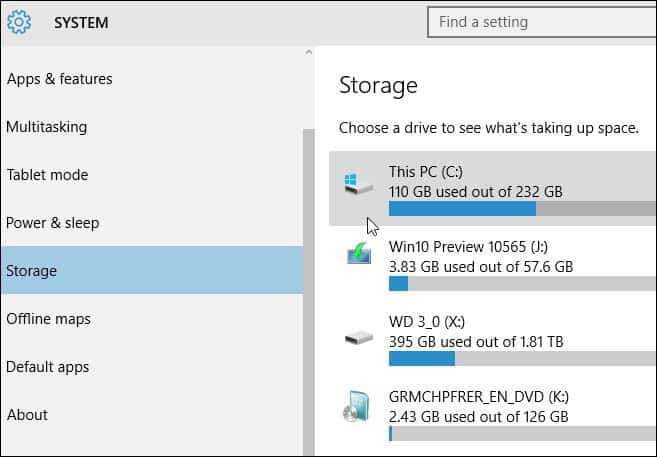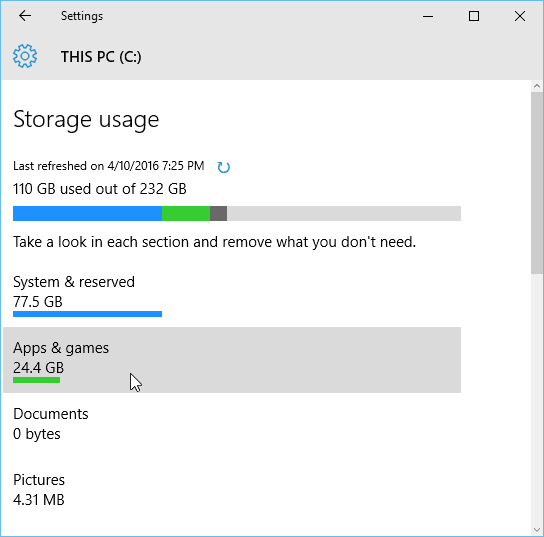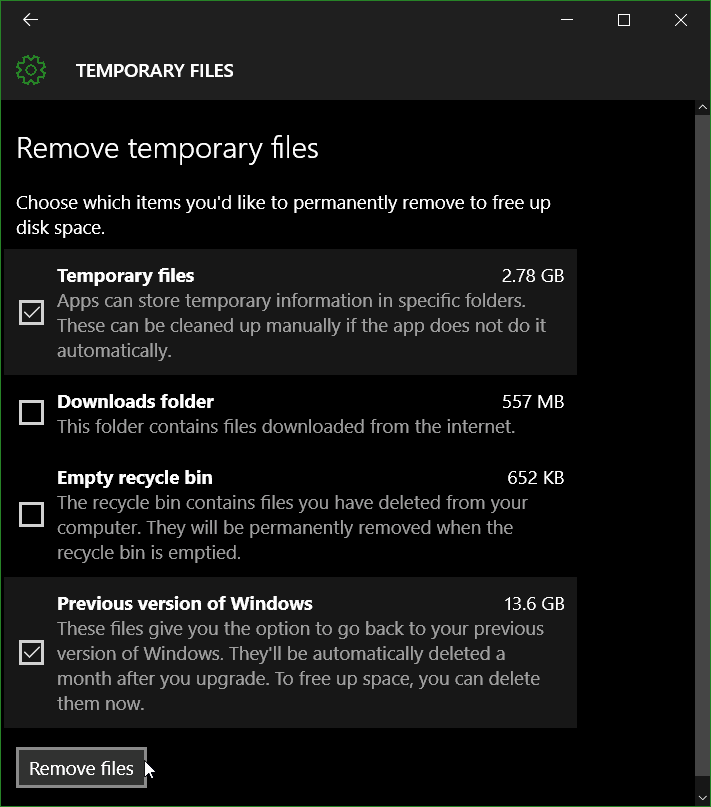Free Up Disk Space on Windows 10 Using the Settings App


As Microsoft continues to update and improve Windows 10, it’s moving away from the Control Panel and putting those options in the Settings app.
As Microsoft updates Windows 10, it moves away from the Control Panel and puts those options in the Settings app. Eventually, you’ll be able to access most, if not all, system maintenance options in one central location with a new interface.
For example, if you want to update Windows 10 manually, you go to Start > Settings > Update & Security > Windows Update. We’ve shown you how to save disk space by removing temp files and previous versions of Windows after an update using the traditional Disk Cleanup option. Here’s a look at getting the same thing done using the Windows 10 Settings app.
Free Up Disk Space Using Windows 10 Settings App
Open the Settings app and go to Start > System > Storage and from there select This PC (which is typically (C:) and is your local drive).


Then wait while Windows calculates what is taking up space on your drive. You’ll get a breakdown of different categories like apps, documents, music, mail, and more. Click on any of those categories to find unnecessary items that you can delete.


If you click on Apps & Games, you’ll be able to go through and delete what you no longer need or want. Just click or tap the app and then Uninstall. Other sections like music, documents, or videos will open the folder location so you can manually delete files.


When it comes to taking up a bunch of disk space, the typical culprit is temp files. Just scroll down and click or tap Temporary files. You can delete temp files, downloads, the recycle bin, and previous versions of Windows if it exists.


Of course, you’ll find the previous version file after doing a major update like last year’s November update or the upcoming Anniversary update this summer.


The screenshot below is from Preview Build 14316 and gives you an idea of how removing temporary files will look in the Anniversary update, which includes a new Dark Mode.


For more tips on getting your disk space back, check out our guide to freeing up drive space on Windows 10 PCs. Also, read how to configure the Storage Sense feature on Windows 10.
4 Comments
Leave a Reply
Leave a Reply







James
Thanks Brian,
Yes – we should all learn, and get some frequent practice with space management
BUT
I’d add to the space management – removing the files that your browser has stored in it’s cache/temporary internet store – wherever depending on your browser.
While most browsers allow you to limit the space occupied by those files, there are probably a large number of small files – many with long names and such small size that Windows will store all the files details and data in the MFT –
OK You’d think what do 9MB of files matter, but if that is, 9MB of files are typically 100 bytes of data, that’s 90,000 file entries taking up unmentioned space in the MFT file control tables – and that has to be read through whenever you use File Explorer, or have an app that searches for any file
Yes @ slightly over 200 bytes for each file’s details that means that the OS has to read past maybe 30MB of extra file details every time the MFT is scanned –
So – does your system seem slow updating lists of files, or renaming files –
get rid of the mass of small files associated with browsing the web, and see your system get much faster managing files.
And don’t forget the trick to stop Windows spending time and effort checking the filetypes in a folder to determine if it should present the list as a set of music, or other files – and not show dates & sizes.
OK – yes – you’ll still need to consider clearing out unwanted files by volume – but on large partitions/drives the MFT clagging problem can have more effect than space usage.
Ray
First, I do not appreciate the Settings App because it is harder to find the function you want to use.
Second, while cache uses disk space, it is there for a reason. In the example of Chrome it reduces your internet use on commonly access pages. Like Facebook.
James
Tay,
Agreed about settings being harder to find the appropriate entry for the controls you want to set.
But that’s probably associated with the evolution of Microsoft’s philosophy about the intelligence of it’s users and what they should be (allowed) to see and do.
Remember Win7 was your copy of Windows on your PC – Windows 10 is Microsoft’s copy of Windows on the PC you are using.
Re cache – my point is not about the space used for it, but the effect on almost everything you do on the PC.
The point of storing the data is that it avoids the need to repeatedly transfer ‘stuff’ over the comms links, which has a substantial effect on your browsing when your link is slow.
BUT
having thousands of extra entries in the file management store (MFT) on a system means that ALL processes looking for files, and consequently the entries in the MFT means that the entries wanted are getting spread out and that will reach a point where the memory space allocated for processing the MFT is not large enough to hold the entire MFT, so – you go from no paging of the MFT to suddenly having to re-read thousands of entries every time something goes to the MFT for a file entry.
So – your processing of 30 files each being 1000 bytes goes from 30,000 bytes read/written and maybe 6000 bytes of MFT re-written to the drive to add maybe an extra 100MB of reads to re-read MFT entries that used to, but no longer all fit in the allocated memory.
Think of it like having 1 layer of pages on a whiteboard – you can see all at a glance –
Now have another layer of paper – as in some of the entries are multiple pages – but you can only see the top page at a glance – you have to go and examine each visible page to see if there is another page under the one you can see.
That takes so much longer.
Similarly, suddenly the OS cannot see all the MFT entries (In real memory), and it starts having to swap the data with stuff held on the disk.
So – another way of considering the effect –
You have space for 10 blocks of data to show on the screen – and you have 9 blocks to view – OK – no problem
10 blocks to view – no worry
11 blocks – Ah you have to swap 1 block out to view the 11th use the block 1 space
Now you want 1 again – OK use the 2 block for 1, now you want 2 – use the 3 block.
(The computer is sort of simple and considers 1 should be kept as you used that recently!)
Follow the process and, while repeatedly searching the content of 1 through 10 is no problem – load them up once. BUT to repeatedly search 11 means reading all 11 every time you search.
Now looking for the files in a folder may mean reading thousands of blocks of the MFT
So – the consideration YOU have to manage is to balance the number of files held against the time to read through the MFT for every app you run, or just re-get the files needed for what you are browsing.
Jaydeb Nilson
Duplicate Files Deleter Program is superb to find and delete duplicate files from your computer. It searches throughout your computer, create a list of duplicate files and present them before you for deciding what you want to do with these files. A great way to free space of your disks. If you will try you will love it.